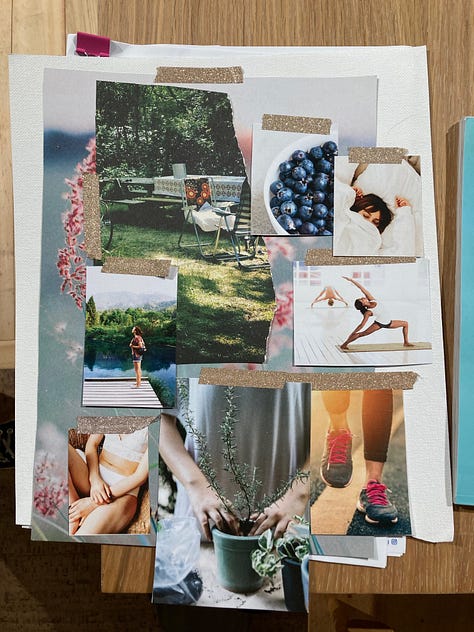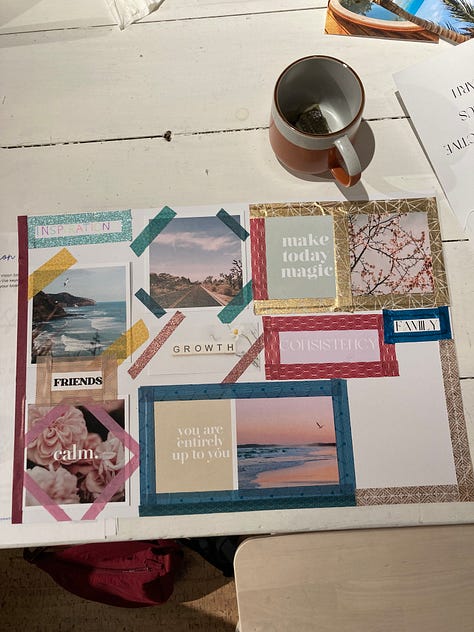2 visualisation techniques to bring change in your life
Imagine the future that you want to build and take the first steps to achieve your goals
Visualisation, vision boards… what’s that all about? I discovered these tools when I left my corporate career and they’ve really helped me get to where I am today. I use visualisation techniques with almost every one of my clients too.
These two techniques are particularly useful if you feel stuck, aimless, unhappy with where you are now.
Creating the vision of your future will help you take action and make the right decisions. It will give you a direction to aim for and a path to get there. It’s about connecting your future goals and dreams to what you can start doing now.
When you want to visualise something, you use your thoughts to imagine a certain outcome, and what you will do to get there.
The science behind it (1)
There has been several scientific studies showing that the brain doesn’t know the difference between imagining something and doing it. You can trick your brain and condition your mind and your body to reach the outcome you want.
Your brain is stimulated the same way whether you’re physically performing an action or simply visualising it happen. The same cascade of neurochemicals is triggered, regardless of whether you are thinking about the past, present, or future. These neurochemicals then affect your motor control, attention, and planning, which spur you into action.
This process of imagining future outcomes also creates new neural networks in your brain that help you form new beliefs, take new actions, and adopt new perspectives. You start to view the world differently and act in new ways to achieve your big goals.
Visualisation stimulates an area of the brain called the Reticular Activating System, which scans your environment looking for new opportunities. When visualising specific goals, the brain will notice new things and filter out unnecessary information, making you more alert to notice what serves your goals.
How does it actually work?
Visualisation requires you to create a picture (more or less detailed) based on previous knowledge and wisdom. It's different from imagination, which is about setting your mind free and thinking about situations that may be hypothetical.
Visualisation is thinking about being hugged by someone.
Imagination is thinking about being hugged by a snowman.
Athletes visualise themselves scoring a goal, going down a slope, running a marathon. They rehearse their moves, from start to finish. Sports psychologists say that visualisation is effective for improving athletic performance, creative thinking and strength. Check out this video of Formula One drivers Max Versappen and Carlos Sainz:
Guided visualisations are widely used in the field of personal growth. They are powerful because they are written and narrated in a way that helps you relax and create your own mental image. There are visualisations for a lot of different topics: from making decisions and speaking in public to tackling the fear of flying or overcoming shyness. You can find some examples here.
Write the vision of your future
You may have a hazy picture of your lifestyle or you may already have some very specific details in mind. When I’ve done this exercise with coaching clients, some have found it really hard to visualise certain areas of their life.
I’ve put together a set of questions that will help you structure your thoughts and outline the future life that you’d like to build. You can skip some questions if you find them too difficult to answer and come back to them later.
Some questions you might answer with a simple “same as now”. But in my experience, you’ll always find that there’s something you want to do differently in the future.
Once you’ve laid out the foundations of your future life, you can start drafting goals, or intentions, that will bring tangible change in your current life. Don’t worry about making them SMART, we’re not doing your annual performance appraisal here. For each area of life (there are nine of them), you could consider doing something new or you can decide to stop doing something that doesn’t serve you (and your future vision) anymore.
With these intentions in mind, you’ll be able to start taking action.
Create a vision board
If you want to make your goals and vision more tangible, you could make a vision board.
It’s a collage of images and words that will bring your vision to life and inspire you to keep making change happen.
There are lots of different ways to create a vision board: you can cut and paste pictures and words on a piece of cardboard; your can draw; you can design one on Canva or Trello. I really enjoyed doing mine (my first one lasted three years!) and running workshops to help others make their vision board.
Here’s an article I wrote outlining the four steps to create an inspiring vision board.






What now?
If you feel visualising your future can help you, download the worksheet, grab a pen and free-up at least one hour to write your vision of the future. Then you can block some more time to work on your vision board.
If you’re struggling to do this on your own, don’t panic, don’t beat yourself up. Lots of my clients come to the session with that feeling and by talking through it they start sketching the edges of their vision and find clarity. You could talk to a friend (who’s a good listener and will be happy to be the recipient in this process) or to a coach (book a discovery call with me if you want to chat) to help you write your vision. You could also find a vision board workshop near you to be guided through the process.




